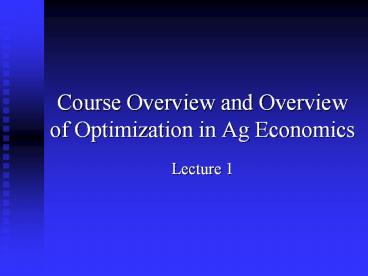Course Overview and Overview of Optimization in Ag Economics - PowerPoint PPT Presentation
1 / 24
Title: Course Overview and Overview of Optimization in Ag Economics
1
Course Overview and Overview of Optimization in
Ag Economics
- Lecture 1
2
Course Outline
- Static Optimization
- Overview of Optimality
- Review of Linear Algebra
- Optimality Conditions
- Algorithms
- Optimization on a Computer
3
- Dynamic Optimization
- A Review of Dynamic Mathematics
- Calculus of Variations
- Optimal Control
- Applications of Optimal Control
4
Overview of Optimization
- The Basic Microeconomic Problem
- Definition of Economics
- The Consumers Problem
5
- The Producers Problem
6
Food and Diet Problem
- Agricultural applications of the food and diet
problems include both human and animal diets. - The food and diet research can be characterized
by two major focuses - Least cost combination of foods to meet dietary
needs. Stiglers Cost of subsistence. - Least cost feed ration studies.
7
- The basic application would involve minimizing
the cost of a diet subject to some nutritional
constraint - c is a vector of prices for each food,
8
- x is a vector of choice levels for each food,
- A is a matrix of nutrients provided by each
food, and - b is a vector of minimum nutritional requirements.
9
- More advanced formulations of the diet problem
have been developed in the guise of the household
production model. - General form household production problem
10
- where F(x) denotes the production relationship
between purchased foodstuffs and consumable goods
(y). - p is the price vector for purchased foodstuffs,
and - I is income
11
- A linear formulation of such a model can be
expressed as - In addition to foodstuffs, x can be augmented to
include labor use.
12
Farm and Agribusiness Management
- Initially, linear programming was used to find
optimal crop mix. This work has grown into large
extension farm planning efforts such as OK farms.
These models tend to be either general linear or
integer
13
- x could be a vector of possible crop
alternatives (wheat, cotton, and oats), - c was a conformable vector of net returns from
each crop activity, - A is a matrix of resource constraints
- b is the vector of resource constraints.
14
- One way that risk may enter the farm management
model is by complicating the objective function
15
- where E. is the expected value operator, U(.)
is the utility function, - A is the resource coefficients,
- b is the vector of resource constraints, and
- x is the level of each activity.
16
- Freund shows that given that preferences are
negative exponential and returns are normally
distributed, the expected utility function
becomes
17
- Therefore, the maximization problem becomes a
nonlinear optimization problem
18
- However, given that few closed form conjugates
exist, technologies have evolved to allow direct
optimization of more generalized problems
19
Farm Firm Development
- The typical farm firm development model is
primarily interest in firm growth.
20
- Focusing on the first two constraints
- So decisions made in year 1 could also affect the
resources available in year 2.
21
- Again generalizing the model, a decision in year
1 may have multiple possible outcomes
22
- p1 denotes the probability of event 1 occurring,
p2 is the probability of event 2 occurring, and
p3 is the probability of event 3 occurring. - If event 1 occurs, the profit vector c12 and T12
resources transfer to period 2.
23
Production Response
- Production response models have been used to
study the impact of some policy or external shock
to the sector. - From the firm level, the effect of changing
fertilizer prices, labor availability, or support
prices on firm outputs, profits, and input
demands can be mapped out, much like the duality
approach to production.
24
- The firm level effects are then aggregated to the
sector level. - An example of this type of model is CARD.































